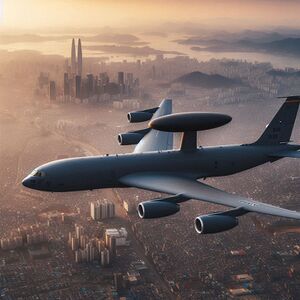KEW-01 Mangru: Difference between revisions
Jump to navigation
Jump to search
No edit summary |
No edit summary |
||
| Line 21: | Line 21: | ||
|} | |} | ||
The '''KAI KEW-01 Mangru''' is a Joseon's airborne early warning and control (AEW&C) aircraft developed by Korea Aerospace Industries, Ltd. KEW-01s are commonly known as AWACS (Airborne Warning and Control System). Derived from the Daesung PA14 airliner, it provides all-weather surveillance, command, control, and communications, and is used by the [[Royal Joseon Air Force]]. Production of The KEW-01 Block I ended in 2003 after 24 aircraft had been built, and Block II has been in production since 2031. | The '''KAI KEW-01 Mangru''' is a [[Joseon]]'s airborne early warning and control (AEW&C) aircraft developed by Korea Aerospace Industries, Ltd. KEW-01s are commonly known as AWACS (Airborne Warning and Control System). Derived from the Daesung PA14 airliner, it provides all-weather surveillance, command, control, and communications, and is used by the [[Royal Joseon Air Force]]. Production of The KEW-01 Block I ended in 2003 after 24 aircraft had been built, and Block II has been in production since 2031. | ||
==Development== | ==Development== | ||
Revision as of 10:38, 11 September 2024
| KEW-01 Mangru | |
|---|---|

| |
| KEW-01 flying over Incheon Metropolitan City. | |
| Role | Airborne Warning and Control System (AWACS) |
| National origin | Joseon |
| Manufacturer | Korea Aerospace Industries, Ltd. |
| First flight | 4 October 1996 (Block I) 9 August 2030 (Block II) |
| Introduction | 10 May 2000 (Block I) 8 September 2032 (Block II) |
| Status | In service |
| Primary user | Royal Joseon Air Force |
The KAI KEW-01 Mangru is a Joseon's airborne early warning and control (AEW&C) aircraft developed by Korea Aerospace Industries, Ltd. KEW-01s are commonly known as AWACS (Airborne Warning and Control System). Derived from the Daesung PA14 airliner, it provides all-weather surveillance, command, control, and communications, and is used by the Royal Joseon Air Force. Production of The KEW-01 Block I ended in 2003 after 24 aircraft had been built, and Block II has been in production since 2031.